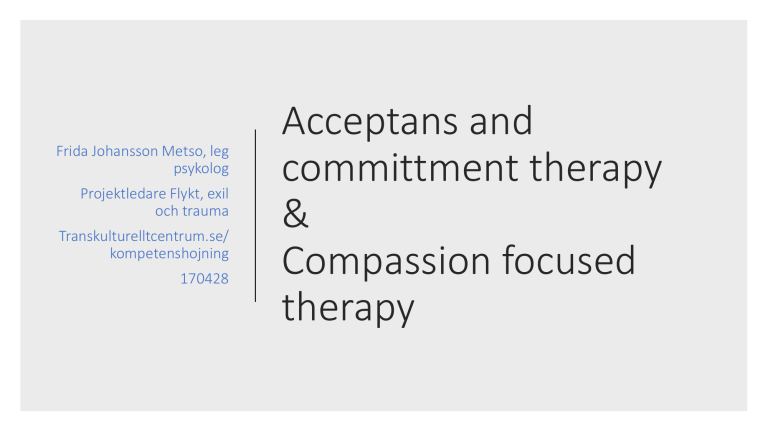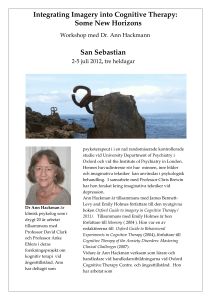
Frida Johansson Metso, leg
psykolog
Projektledare Flykt, exil
och trauma
Transkulturelltcentrum.se/
kompetenshojning
170428
Acceptans and
committment therapy
&
Compassion focused
therapy
Smärta och
lidande är inte
samma sak
”Pain is inevitable in life; suffering is
not” S. Hayes
”Although the world id full of
suffering, it is full also of the
overcoming of it” H. Keller
”Between stimulus and respons there
is a space. In that space lies our
freedom and our power to choose our
response. In our response lies our
growth and our happiness.” V. Frankel
Acceptans
Värderad riktning
Före trauma
Traumatisk
händelse
Posttrauma
Pretraumatic
Traumatic
Posttraumatic
Now
Kompassionfokus
erad terapi är vad
du redan gör
Compassion focused therapy
Behandlarens träning
1.
2.
3.
4.
5.
Det är förståeligt att kämpa med mitt arbete
– många av mina patienter har varit med om
svåra tragedier och komplexa händelser.
Många behandlare har svårigheter med
någon patient.
Jag kan minnas patienter som jag hjälpt.
Att stå ut och lära mig att hantera svåra
känslor som dessa är viktigt för mig.
Jag vågar be andra om hjälp om jag behöver
för att hjälpa mig och mina patienter.
Tips på litteratur
•
Rein, Atkinson & McCraty (1995) The physiological and psychological effects of compassion and anger, Journal for the advancement of
Medicine, 8: 87-105. visar att CFT (mentalisering) stärker immunförsvaret.
•
Lutz, Brefczynski-Lewis, Johnstone och Davidson (2008) Regulation of the neural circuitry of emotion by compassion meditation: Effects of the
meditative expertise, Public Library of Science, 3: 1-5.visar att CFT stimulerar frontalloben, immunsystem och välmående.
•
Hutcherson, Seppala och Gross (2008), Loving-Kindness Meditation Increases Social Connectedness. Emotion, 8, 720-724., visar att CFT stärker
upplevelsen av social tillhörighet och positiva känslor mot främlingar.
•
Fredrickson, Cohn, Coffey, Pek och Finkel (2008) Open hearts build lives: Positive emotions, induced through loving-kindness meditation, build
consequential personal resources, Journal of personality and social psychology, 95: 1045-1062, fann positiva effekter på positiva emotioner,
mindfulness, upplevelse av syfte med livet, minskade sjukdomsupplevelser och ökad upplevelse av socialt stöd.
•
Pace, Negi och Adame (2008), Effects of compassion mediation on neuroendroctine, innate immune and behavioral response to psychosocial
sress, Psychoneuroendocrinology, doi: 10. 1016/j., fann positiva effekter på immunsystemet.
•
Gilbert och Procter (2006) , Compassionate mind training for people with high shame and self-criticism: A pilot study of a group therapy
approach, Clinical Psychology and Psychotherapy, 13:353-379, visade positiva förbättringar rörande skam, depression och ångest i klinisk
population.
•
Mayhew och Gilbert (2008), Compassionate mind training with people who hear malevolent voices: A case series report, Clinical psychology and
psychotherapy, 15: 113-138, har funnit positiva effekter bland personer med psykotiska hörselhallucinationer.
•
Laithwaite et al (2009), Recovery after psychosis (RAP): A compassion focused programme for individuals residing in high security settings,
Behavioural and Cognitive Psychotherapy, 37:511-526, fann positiva effekter på depression och skam inom psykiatrisk slutenvård.
•
Cacioppo, Berston, Sheridan och McClintock (2000), Multilevel integrative analysis of human behavior: Social neuroscience and the
complementing nature of social and biological approaches, Cozilino (2007), The neuroscience of human relationships: Attachment and the
developing brain, och (2008), The healthy aging brain: sustaining attachment, attaining wisdom, och Crocker & Canevallo (2008) Creating and
undermining social support in communal relationships: the role of compassionate and self-image goals, sammanfattar god evidens för att CFT
påverkar relationer positivt, vilket påverkar välmående och psykisk hälsa.
•
Metastudie om positiva effekter: Fehr et al., 2009, The science of compassionate love: theory research and application. Chichester, UK: Wiley.
•
För att kunna känna annorlunda – och få belöning/positiv feedback/uppleva trygghet efter beteendeexperiment – behöver vi kunna komma åt
våra belönande, lugna system (Leahy, 2001), Overcoming resistance in cognitive therapy,. (Stott, 2007); When the head and heart do not agree:
a theoretical and clinical analysis of rational-emotional dissociation in cognitive therapy, (Wills, 2009) Beck’s cognitive therapy: distinctive
features. London: Routledge.
Boktips från föreläsningen
• Compassion Focused Therapy: Distinctive Features (CBT Distinctive Features), Paul
Gilberg
• Compassionfokuserad terapi, Christina Andersson, Sofia Viotti
• Acceptance and Commitment Therapy for the Treatment of Post-Traumatic Stress
Disorder and Trauma-Related Problems: A Practitioner's Guide to Using
Mindfulness and Acceptance Strategies, Robyn D. Walser mfl
• Finding Life Beyond Trauma: Using Acceptance and Commitment Therapy to Heal
from Post-Traumatic Stress and Trauma-Related Problems (New Harbinger SelfHelp Workbook), Victoria M. Follette mfl
Artiklar:
• “Do you practice what you preach?” A qualitative exploration of therapists’
personal practice of compassion focused therapy, Corinne Galen mfl (2015)
• The origins and nature of compassion focused therapy, Paul Gilberg (2014)
Exempel på uppgifter
till bingobrickan:
• Gör värderingsövningen själv när det behövs
• När du är arg på någon du bryr dig om – går
det att aktivera ett gemensamt positivt
minne?
• Berätta för en patient om de tre systemen
och att man i hotsystemet inte har tillgång
till hela hjärnan
• Brevskrivande med compassion
• Läs artikeln om CFT för behandlare
• Minns när andra visat vänlighet mot dig
• Minns när du visat vänlighet mot andra
• Välj en situation och föreställ dig innan hur
du skulle agera om du var ditt mest
compassionate self. Välj inte den svåraste
patienten!
• Konstruera ett objektivt själv –
compassionself. Fake it till you make it.
















